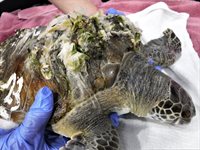
The majority of the new admits came down from the Cape Lookout area. All but one, a fairly good sized juvenile loggerhead, are small greens. And as usual they came with pretty heavy loads of mud, sand, barnacles and algae. One of the most interesting is a little guy, or maybe girl, that came in wearing an “outfit” that was so outrageous it would have gotten the designer kicked off of Project Runway. It’s colorful, but beyond that we have no words.
While Jean examined, triaged and set up the initial medical protocols for the new arrivals our volunteers gathered tanks so we could get these turtles out of banana boxes and into water to begin rehydrating. Most were initially kept on squishy towels for the first few days while we assessed their physical condition and their tolerance for higher levels of water.
It’s hard to adequately describe the tremendous amount of work that goes into getting these turtles out of imminent danger and on the road to recovery.
Their water is changed three times daily, they are fed twice every day, they are given gentle soapy baths followed by topical and IV treatment and they are showered with love by our staff. During feeding time their water is raised while our volunteers spend literally hours crawling along the concrete floor with food while monitoring them for any signs of distress. They are checked time and time again during the day and into late night for any problems that might suddenly show up.
In addition to the man hours involved we are using almost sixty pounds of fish and five pounds of squid every day, and these critters are just beginning to get their appetites back. Factor in the daily salt requirement (fifteen to twenty boxes) and the additional water necessary to get to the right salinity (about 4,000 - 5,000 gallons.) That will ramp up once we get everybody back into “normal” water levels. Now throw into the mix the fantastic people who attended the cold stun orientation classes who are now coming in, and mostly hanging in there with us the entire 12-14 hour day, to help our regular staff with the work. We arrive in the dark relatively clean, and leave in the dark smelly and dirty. Is it worth it? You bet!
And we’re not the only ones who think all of this work is worth the effort. There have been two major cold stunning events so far this winter. The NC Wildlife Resources Commission heads up the monumental task of managing the process, from getting these critters off the beaches to placing them in various facilities for care and planning for their release. And you’re familiar by now with our long term relationship with the NC State School of Veterinary Medicine and our turtle vet Dr. Harms’s work at their satellite CMAST in Morehead City. All of our NC State Aquariums are working along with us to care for cold stuns: Ft. Fisher, Pine Knoll Shores, Roanoke Island, the STAR Center and Jennette’s Pier. And pretty much every state and federal entity that is in any way related to coastal waters pitches in during a cold stun crisis. Everyone, whether they are employed by one of these agencies or just a concerned citizen who loves the ocean and these wonderful creatures who are just trying to survive steps up to help. Just when it seems that the world has become more cynical and less caring this happens and restores our faith in humanity.
Now you know why we keep repeating these basic steps in case you find a cold stun turtle. Just because a turtle is not moving it doesn’t necessarily mean it is dead. It might just be cold stunned. If it’s a little guy gently pick it up and relocate it to a car, garage or other unheated area of your home. DO NOT try to warm it up – the shock of a quick temperature change could send it into shock. We’ll send our staff out to rescue any and all turtles, big and small when you give us the word. Call one of the following numbers if you suspect you’ve come across a local cold-stunned turtle: Hospital contacts are Terry Meyer @ 910-470-2880 and Jean Beasley @ 910-470-2800 . We will also pick up on the hospital line ( 910-329-0222 ) if the call comes into us during normal hospital hours. The state of NC has a stranding hotline that picks up 24/7: 252-241-7367
We are closed to the public until April of 2020. Thank you for supporting us. See you next year!
This sea turtle hospital update was written by Karen Sota of the Karen Beasley Sea Turtle Rescue and Rehabilitation Center



